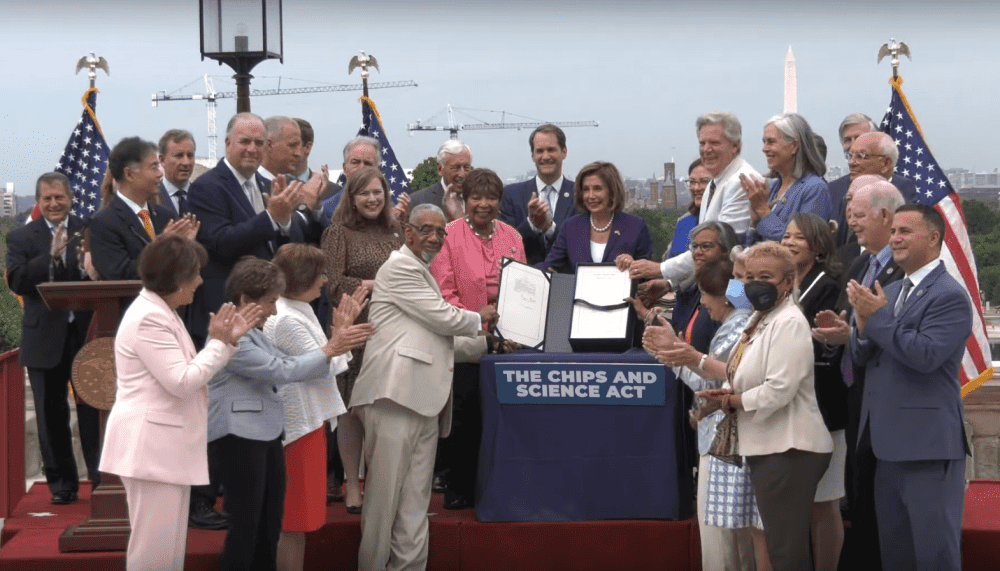
[Image above] House Speaker Nancy Pelosi held a bill enrollment ceremony for the CHIPS and Science Act on Friday, July 29, a day after its passage in the U.S. House of Representatives. Credit: Nancy Pelosi, YouTube
Last Thursday, July 28, the United States House of Representatives approved the CHIPS and Science Act of 2022, sending the legislation to President Joe Biden for his signature.
This act, colloquially called CHIPS+, is the culmination of months-long negotiations between the House and Senate to reconcile their America COMPETES Act of 2022 and U.S. Innovation and Competition Act (USICA), respectively. Congress negotiators ultimately agreed to pull out and pass a narrow set of science provisions as CHIPS+ while they continue debating the more controversial provisions of COMPETES and USICA.
The $52 billion for semiconductor R&D and manufacturing is likely the most talked about provision of CHIPS+. This money will fund programs established under the Creating Helpful Incentives to Produce Semiconductors for America (CHIPS) Act, which passed as part of the fiscal year 2021 National Defense Authorization Act.
The passage of CHIPS program funding is great news for the state of Ohio, where semiconductor chip manufacturer Intel is planning to build a manufacturing mega-site near the state’s capital. Recently, Intel delayed a groundbreaking ceremony for its $20 billion project citing the lack of CHIPS funding. However, following passage of CHIPS+ by the House last Thursday, Intel CEO Pat Gelsinger announced the company is ready to move “full speed ahead” on the project.
(Though Intel hopes to secure $12 billion of the construction grants, or nearly a third of the total, other companies angling for the money include two chipmakers that surpass Intel in mastering the most advanced chipmaking techniques: TSMC, which is building a $12 billion fabrication plant in Arizona, and Samsung, which is working on a $17 billion facility in Texas. The U.S. Department of Commerce has not yet revealed the application process nor said how it will pick priorities for taxpayer support.)
Also included in CHIPS+ is a framework for the National Science Foundation’s new Directorate for Technology, Innovation, and Partnerships (TIP). The TIP directorate was officially endorsed in the final fiscal year 2022 funding package, but the mission and scope of the directorate remained unclear due to differing visions in the House and Senate. CHIPS+ merges these frameworks, requiring the TIP directorate to focus on not more than five “societal, national, and geostrategic challenges” and not more than 10 “key technology focus areas,” with each list subject to periodic revision.
In addition to these provisions, CHIPS+ sets aggressive growth targets for the topline budgets of NSF, NIST, and the DOE Office of Science, as well as for certain major programs within each agency. An FYI article describes out how the funding will be distributed among these agencies. Notably, in contrast to the semiconductor funds, the agency funds are only “authorizations,” meaning Congress is not obligated to provide the money and will decide whether to meet the targets on a year-by-year basis.
Further details on the CHIPS+ provisions can be seen on the House Committee on Science, Space, & Technology website.
Biden originally planned to visit Michigan today to talk about the CHIPS+ Act. However, after testing positive for COVID-19 again on Saturday, he is once again isolating until further notice.
Author
Lisa McDonald
CTT Categories
- Market Insights


